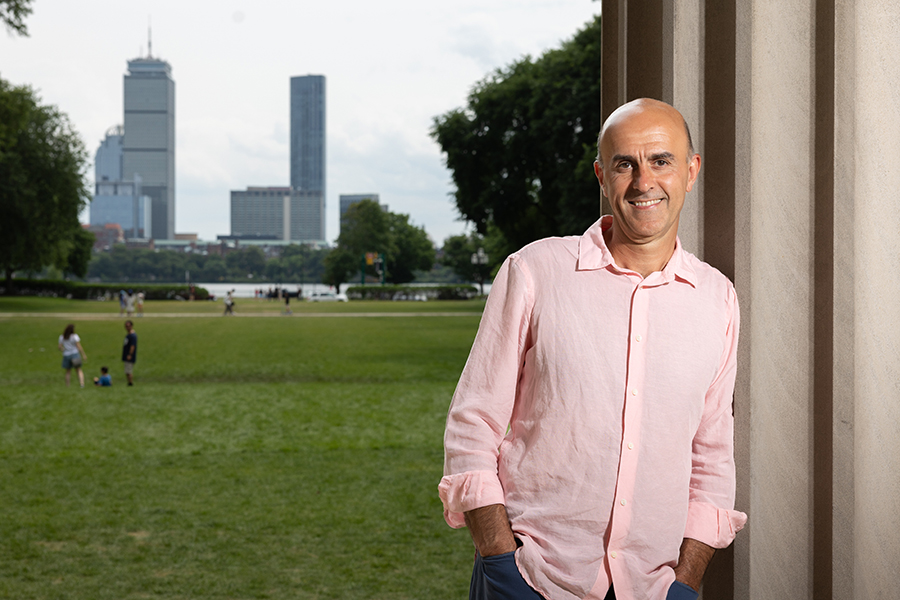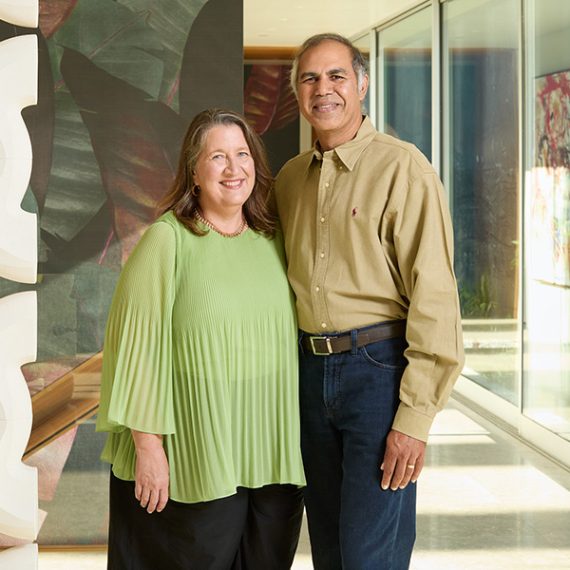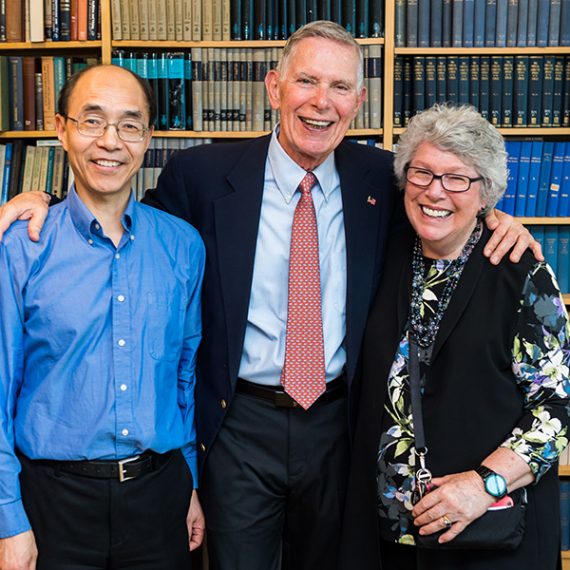Mehrdad Jazayeri selected as an HHMI investigator
Appointment to the Howard Hughes Medical Institute will provide support that Jazayeri will use to explore how the brain enables rapid learning and flexible behavior.

The Howard Hughes Medical Institute (HHMI) has named McGovern Institute neuroscientist Mehrdad Jazayeri as one of 26 new HHMI investigators—a group of visionary scientists who HHMI will support with more than $300 million over the next seven years.
Support from HHMI is intended to give its investigators, who work at institutions across the United States, the time and resources they need to push the boundaries of the biological sciences. Jazayeri, whose work integrates neurobiology with cognitive science and machine learning, plans to use that support to explore how the brain enables rapid learning and flexible behavior—central aspects of intelligence that have been difficult to study using traditional neuroscience approaches.
Jazayeri says he is delighted and honored by the news. “This is a recognition of my lab’s past accomplishments and the promise of the exciting research we want to embark on,” he says. “I am looking forward to engaging with this wonderful community and making new friends and colleagues while we elevate our science to the next level.”
An unexpected path
Jazayeri, who has been an investigator at the McGovern Institute since 2013, has already made a series of groundbreaking discoveries about how physiological processes in the brain give rise to the abilities of the mind. “That’s what we do really well,” he says. “We expose the computational link between abstract mental concepts, like belief, and electrical signals in the brain,” he says.
Jazayeri’s expertise and enthusiasm for this work grew out a curiosity that was sparked unexpectedly several years after he’d abandoned university education. He’d pursued his undergraduate studies in electrical engineering, a path with good job prospects in Iran where he lived. But an undergraduate program at Sharif University of Technology in Tehran left him disenchanted. “It was an uninspiring experience,” he says. “It’s a top university and I went there excited, but I lost interest as I couldn’t think of a personally meaningful application for my engineering skills. So, after my undergrad, I started a string of random jobs, perhaps to search for my passion.”
A few years later, Jazayeri was trying something new, happily living and working at a banana farm near the Caspian Sea. The farm schedule allowed for leisure in the evenings, which he took advantage of by delving into boxes full of books that an uncle regularly sent him from London. The books were an unpredictable, eclectic mix. Jazayeri read them all—and it was those that talked about the brain that most captured his imagination.
Until then, he had never had much interest in biology. But when he read about neurological disorders and how scientists were studying the brain, he was captivated. The subject seemed to merge his inherent interest in philosophy with an analytical approach that he also loved. “These books made me think that you actually can understand this system at a more concrete level…you can put electrodes in the brain and listen to what neurons say,” he says. “It had never even occurred to me to think about those things.”
He wanted to know more. It took time to find a graduate program in neuroscience that would accept a student with his unconventional background, but eventually the University of Toronto accepted him into a master’s program after he crammed for and passed an undergraduate exam testing his knowledge of physiology. From there, he went on to earn a PhD in neuroscience from New York University studying visual perception, followed by a postdoctoral fellowship at the University of Washington where he studied time perception.
In 2013, Jazayeri joined MIT’s Department of Brain and Cognitive Sciences. At MIT, conversations with new colleagues quickly enriched the way he thought about the brain. “It is fascinating to listen to cognitive scientists’ ideas about the mind,” he says. “They have a rich and deep understanding of the mind but the language they use to describe the mind is not the language of the brain. Bridging this gap in language between neuroscience and cognitive science is at the core of research in my lab.”
His lab’s general approach has been to collect data on neural activity from humans and animals as they perform tasks that call on specific aspects of the mind. “We design tasks that are as simple as possible but get at the crux of the problems in cognitive science,” he explains. “Then we build models that help us connect abstract concepts and theories in cognitive science to signals and dynamics of neural activity in the brain.”
It’s an interdisciplinary approach that even calls on many of the engineering approaches that had failed to inspire him as a student. Students and postdocs in the lab bring a diverse set of knowledge and skills, and together the team has made significant contributions to neuroscience, cognitive science, and computational science.
With animals trained to reproduce a rhythm, they’ve shown how neurons adjust the speed of their signals to predict when something will occur, and what happens when the actual timing of a stimulus deviates from the brain’s expectations.
Studies of time interval predictions have also helped the team learn how the brain weighs different pieces of information as it assesses situations and makes decisions. This process, called Bayesian integration, shapes our beliefs and our confidence in those beliefs. “These are really fundamental concepts in cognitive sciences, and we can now say how neurons exactly do that,” he says.
More recently, by teaching animals to navigate a virtual environment, Jazayeri’s team has found activity in the brain that appears to call up a cognitive map of a space even when its features are not visible. The discovery helps reveal how the brain builds internal models and uses them to interact with the world.
A new paradigm
Jazayeri is proud of these achievements. But he knows that when it comes to understanding the power and complexity of cognition, something is missing.
“Two really important hallmarks of cognition are the ability to learn rapidly and generalize flexibly. If somebody can do that, we say they’re intelligent,” he says. It’s an ability we have from an early age. “If you bring a kid a bunch of toys, they don’t need several years of training, they just can play with the toys right away in very creative ways,” he says. In the wild, many animals are similarly adept at problem solving and finding uses for new tools. But when animals are trained for many months on a single task, as typically happens in a lab, they don’t behave as intelligently. “They become like an expert that does one thing well, but they’re no longer very flexible,” he says.
Figuring out how the brain adapts and acts flexibly in real-world situations in going to require a new approach. “What we have done is that we come up with a task, and then change the animal’s brain through learning to match our task,” he says. “What we now want to do is to add a new paradigm to our work, one in which we will devise the task such that it would match the animal’s brain.”
As an HHMI investigator, Jazayeri plans to take advantage of a host of new technologies to study the brain’s involvement in ecologically relevant behaviors. That means moving beyond the virtual scenarios and digital platforms that have been so widespread in neuroscience labs, including his own, and instead letting animals interact with real objects and environments. “The animal will use its eyes and hands to engage with physical objects in the real world,” he says.
To analyze and learn about animals’ behavior, the team plans detailed tracking of hand and eye movements, and even measurements of sensations that are felt through the hands as animals explore objects and work through problems. These activities are expected to engage the entire brain, so the team will broadly record and analyze neural activity.
Designing meaningful experiments and making sense of the data will be a deeply interdisciplinary endeavor, and Jazayeri knows working with a collaborative community of scientists will be essential. He’s looking forward to sharing the enormous amount of relevant data his lab expects to collect with the research community and getting others involved. Likewise, as a dedicated mentor, he is committed to training scientists who will continue and expand the work in the future.
He is enthusiastic about the opportunity to move into these bigger questions about cognition and intelligence, and support from HHMI comes at an opportune moment. “I think we have now built the infrastructure and conceptual frameworks to think about these problems, and technology for recording and tracking animals has developed a great deal, so we can now do more naturalistic experiments,” he says.
His passion for his work is one of many passions in his life. His love for family, friends, and art are just as deep, and making space to experience everything is a lifelong struggle. But he knows his zeal is infectious. “I think my love for science is probably one of the best motivators of people around me,” he says.




